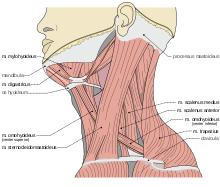Interscalene block
The interscalene blockade (also interscalene brachial plexus blockade according to Alon P. Winnie , interscalene plexus anesthesia ) is a regional anesthetic procedure that enables surgical interventions on the arm and shoulder and, after the operation, effective pain therapy. The roots of the brachial plexus (arm nerve plexus) are reversibly blocked by injecting local anesthetics in the area of the scalene muscles ( stair muscles ) . The interscalene blockade is a relatively easy to carry out procedure with few side effects, which in principle is suitable as the sole anesthetic procedure for interventions on the shoulder / upper arm, but is often combined with anesthesia ( combination anesthesia ), which reduces the need for anesthetics . Usually a pain catheter is inserted ( interscalary catheter , ISK), through which local anesthetics can be applied after the procedure, which enables very efficient pain treatment.
application areas
The interscalene blockade, in particular, numbs the upper part of the brachial plexus, which supplies the outer third of the collarbone , the shoulder and the outside of the upper arm , making the procedure suitable for operations in this area. Anesthesia of the forearm and hand, on the other hand, is only inadequately effected, where an infraclavicular or axillary block is useful.
Contraindications are infections or tumors in the neck / shoulder area as well as rejection or lack of cooperation by the patient. Disorders of blood coagulation or taking anticoagulant drugs represent relative contraindications.
execution
Today the puncture is usually performed using the Meier modification of the Winnie technique. With the head slightly turned to the opposite side, the posterior scalenus gap (between the anterior scalenus muscle and the medius scalenus muscle ) is felt at the rear edge of the sternocleidomastoid muscle ( large head turn ) and punctured slightly laterally towards the middle of the clavicle.
The identification of the nerves can be done in different ways. Usually the search is carried out with the help of a nerve stimulator, which is connected to the end of the puncture cannula. The position of the needle tip near the nerves is shown by muscle twitching in the shoulder (M. deltoideus, M. biceps brachii). Also, ultrasound-guided puncture, optionally in combination to the nerve stimulator is possible.
For punctures with a nerve stimulator, about 40 ml of local anesthetic is injected; for ultrasound-targeted blockages, 10–15 ml of local anesthetic is sufficient for a sufficient blockage. Longer-acting local anesthetics such as ropivacaine are preferred . In order to accelerate the onset of the effect, which takes 10–30 minutes, more rapid and short-acting substances such as prilocaine or mepivacaine are used in combination.
The rear (posterior) puncture according to Pippa is practiced less often.
Side effects
Nerve damage can be caused by direct cannula injury or by toxic effects of local anesthetics that are accidentally injected into the nerves ( intraneurally ). This damage can be avoided by using blunt cannulas and omitting injections in case of paresthesia during the procedure and is extremely rare. Accidental injection into blood vessels (intravascularly) can have effects on the cardiovascular system ( bradycardia , hypotension , cardiac arrest at high doses) or the central nervous system ( seizures , impaired consciousness ).
It is possible that a temporary Horner syndrome occurs due to anesthesia of sympathetic nerve fibers of the stellate ganglion . Anesthesia of the phrenic nerve can also result in unilateral diaphragmatic paralysis and, if the recurrent nerve is numbed, hoarseness. Pre-existing damage to these nerves on the opposite side prohibits the use of interscalene blockade, as failure of these nerves on both sides can lead to shortness of breath.
literature
- QH De Tran, A. Clemente, J. Doan, RJ Finlayson: Brachial plexus blocks: a review of approaches and techniques. In: Can J Anaesth. 54 (8), Aug 2007, pp. 662-674. Review. PMID 17666721
- Danilo Jankovic: Regional blockades and infiltration therapy, 3rd edition. Abw Wissenschaftsverlag, 2003, ISBN 3-936072-16-7 .
- Gisela Meier, Johannes Büttner: Compendium of peripheral blockades. 6th edition. Arcis-Verlag, 2008, ISBN 978-3-89075-177-1 .
Individual evidence
- ^ G. Meier, C. Bauereis, C. Heinrich: The interscalene plexus catheter for anesthesia and postoperative pain therapy. In: Anaesthesiologist. 46 (8), Aug 1997, pp. 715-719. PMID 9382210
- ^ AP Winnie : Interscalene brachial plexus block. In: Anesth Analg. 49 (3), May-Jun 1970, pp. 455-466. PMID 5534420
- ↑ P. Marhofer, M. Greher, S. Kapral: Ultrasound guidance in regional anesthesia. In: Br J Anaesth. 94 (1), Jan 2005, pp. 7-17. Review. PMID 15277302
- ↑ P. Pippa, E. Cominelli, C. Marinelle, p Aito: brachial plexus block using the posterior approach. In: Eur J Anaesth. 7, 1990, pp. 411-420.

